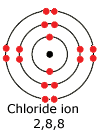|
Atoms of all kinds (except the noble gases) are inherently chemically unstable on their own. We know this because they tend to exist in conjuction with other atoms, either in the form of elements, or compounds. Ionic bonding takes place between metals and non-metals creating a giant structure made up of ions of opposite charges, packed together in a giant crystal lattice. Ionic bonding is the theory used to explain how these giant lattices can be formed from their constituent atoms. In this section we take a look at the various processes involved. Structure 2.1.1 - When metal atoms lose electrons, they form positive ions called cations. When non-metal atoms gain electrons, they form negative ions called anions.
Guidance
Tools and links
|
Electronic configuration and energy
The noble gases have full outer shells and are stable as individual atoms. All of the other atoms have incomplete outer shells and are chemically reactive. The inference is that a full outer shell confers stability on an atomic structure.

|

|
| Reactive, unstable configuration | Unreactive, stable configuration |
Metal atoms have very few electrons in their outer shells and can gain stability by losing these electrons. The electrons cannot just be ejected into space as their removal actually requires energy.
However, if the electrons are transferred to a non-metal atom, forming an ionic pair, then the resultant lowering of energy caused by the mutual attraction of the ions is more than enough to compensate for the energy required to ionise the metal.
Electrons are transferred from metal atom to non-metal atom. In the course of the process both the metal and non-metal atoms attain a noble gas configuration.
The number of atoms that react together is determined by the number of electrons that each atom needs to lose, or gain, to attain a full outer shell. Group 2 metals need to lose 2 electrons. Both of their outer (valence) shell electrons MUST be transferred to suitable non-metal atoms. If the non-metal can only accept one electron, then two metal atoms are needed (and vice versa).
The electrical charge on an ion depends on the number of electrons gained or lost by an atom. This, in turn, depends on the group number of the atom in the periodic table.
Metals are found on the left hand side of the periodic table, they always form positive ions. The magnitude of the positive charge is the same as the group number of the metal.
- Group 1 metals form +1 charge ions, eg Li+, Na+ and K+
- Group 2 metals form +2 charge ions, eg Mg2+, Ca2+ and Ba2+
Non-metals are from the right hand side of the periodic table, they have nearly full outer shells and form negative ions by capturing electrons. The magnitude of the negative charge on the ion is the same as the number of electrons needed to attain a full outer shell.
- Group 16 elements require 2 more electrons to attain a full outer shell, the ionic charge is 2-, eg O2- and S2-.
- Group 17 elements require 1 more electron to attain a full outer shell, the ionic charge is 1-, eg F- and Cl-.
Remember that ALL compounds are neutral so the positive charges of the ions MUST be balanced by the negative charges of the ions.
|
Example: What is the formula of the compound formed between the ions Mg2+ and N3-? The electronic charges must cancel out. Clearly 2+ cannot cancel out 3- so we need another 2+. This makes 4+ altogether which now cannot be cancelled out by the 3-. So we need another 3- making 6- altogether. Now if we add another 2+ we get 6+ to cancel out the 6-. Therefore the formula comes from Mg2+Mg2+Mg2+N3-N3- = Mg3N2 Notice that the ionic charges are NOT included in the formula. |
The transition metals form positive ions, but the charge on the ion can't be predicted from the periodic table. In fact transition metals have a variable oxidation state, meaning that they form several ions. For this reason the valency (which is the same as the ionic charge) has to be included in the compound name, so that we know the type of ion involved.
|
Examples: Names of transition metal compounds copper(II) sulfate, cobalt(II) chloride |
Normally transition metals form 2+ and 3+ ions, although there are exceptions, such as Cu+, Ag+.
The positive ions do not change their names from that of the metals. For example an ion formed from a copper atom is simply called a copper ion. However, the ions formed from non-metals change the end of the name in the ionic form. Simple ions change the ending to -ide.
|
Examples:
|
Elements that are able to form positive ions transfer electrons to elements that are able to form negative ions. In general, this means reactions between metals and non-metals, but be aware that there are exceptions. When the electronegativity difference between the metallic element and the non-metallic element is small, covalent compounds can form. BeCl2, AlCl3 are both covalent compounds
The process follows these steps:
- Transfer of electrons
- Formation of positive and negative ions with full outer shells
- Electrostatic attraction of the positive and negative ions, forming a giant ionic lattice.

